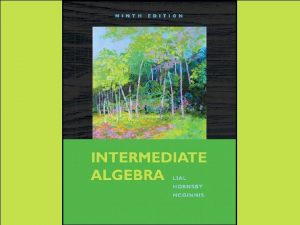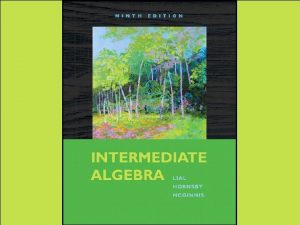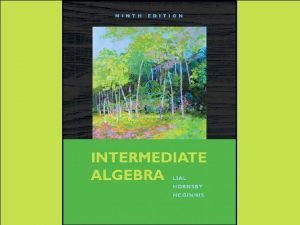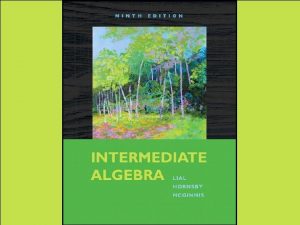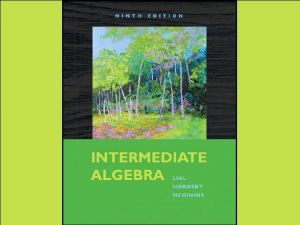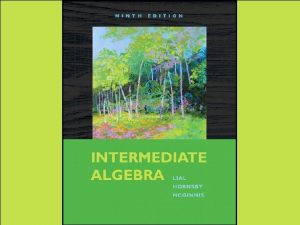Copyright 2010 Pearson Education Inc All rights reserved





















- Slides: 21

Copyright © 2010 Pearson Education, Inc. All rights reserved Sec 12. 1 - 1

Chapter 12 Nonlinear Functions, Conic Sections, and Nonlinear Systems Copyright © 2010 Pearson Education, Inc. All rights reserved Sec 12. 1 - 2

12. 1 Additional Graphs of Functions; Composition Copyright © 2010 Pearson Education, Inc. All rights reserved Sec 12. 1 - 3

12. 1 Additional Graphs of Functions; Composition Objectives 1. Recognize the graphs of the elementary functions defined x , and graph their translations. by | x |, 1 x , and 2. Recognize and graph step functions. 3. Find the composition of functions. Copyright © 2010 Pearson Education, Inc. All rights reserved. Sec 12. 1 - 4

12. 1 Additional Graphs of Functions; Composition The Absolute Value Function The domain of the absolute value function is (– ∞, ∞) and its range is [0, ∞). y x y 0 0 +1 1 +2 2 +3 3 Copyright © 2010 Pearson Education, Inc. All rights reserved. x (0, 0) f(x) = |x| Sec 12. 1 - 5

12. 1 Additional Graphs of Functions; Composition The Reciprocal Function For the reciprocal function, the domain and the range are both (– ∞, 0) U (0, ∞). Notice the vertical asymptote at x = 0 and the y horizontal asymptote at y = 0. x y 1 3 1 – 1 1 2 2 – 1 – 2 1 1 – 1 2 – 2 – 1 3 – 3 – 1 3 2 2 3 Copyright © 2010 Pearson Education, Inc. All rights reserved. x f(x) = 1 x Sec 12. 1 - 6

12. 1 Additional Graphs of Functions; Composition The Square Root Function The domain of the square root function is [0, ∞). Because the principal square root is always nonnegative, the range is y also [0, ∞). x y 0 0 1 1 4 2 (0, 0) f(x) = Copyright © 2010 Pearson Education, Inc. All rights reserved. x x Sec 12. 1 - 7

12. 1 Additional Graphs of Functions; Composition EXAMPLE 1 Applying a Horizontal Shift Graph f ( x ) = | x – 3 |. This graph is found by shifting f ( x ) = | x | three units to the right. The domain of this function is (– ∞, ∞) and its range is [0, ∞). x y 0 3 1 2 2 1 y x 3 0 (3, 0) 4 1 f(x) = |x– 3| Copyright © 2010 Pearson Education, Inc. All rights reserved. Sec 12. 1 - 8

12. 1 Additional Graphs of Functions; Composition EXAMPLE 2 Applying a Vertical Shift Graph f ( x ) = 1 x – 4. This graph of this function is found by shifting 1 y f ( x ) = x four units down. x y 1 3 – 1 – 7 1 2 – 1 – 6 1 – 3 – 1 – 5 2 – 3. 5 – 2 – 4. 5 3 2 Copyright © 2010 Pearson Education, Inc. All rights reserved. x f(x) = 1 – 4 x Sec 12. 1 - 9

12. 1 Additional Graphs of Functions; Composition EXAMPLE 2 Applying a Vertical Shift Graph f ( x ) = 1 x – 4. This graph of this function is found by shifting 1 y f ( x ) = x four units down. The domain is (– ∞, 0) U (0, ∞) and the range is (– ∞, – 4) U (– 4, ∞). Notice the vertical asymptote at x = 0 and the horizontal asymptote at y = – 4. x f(x) = 1 – 4 x Copyright © 2010 Pearson Education, Inc. All rights reserved. Sec 12. 1 - 10

12. 1 Additional Graphs of Functions; Composition EXAMPLE 3 Graph f ( x ) = Applying Both Horizontal and Vertical Shifts x + 2 – 3. This graph is found by shifting f ( x ) = three units down. x two units to the left and The domain of this function is [– 2, ∞) and its range is [– 3, ∞). y x y – 2 – 3 2 – 1 x f(x) = 7 x+2 – 3 0 Copyright © 2010 Pearson Education, Inc. All rights reserved. Sec 12. 1 - 11

12. 1 Additional Graphs of Functions; Composition Greatest Integer Function The greatest integer function, usually written f (x) = follows: x , is defined as x denotes the largest integer that is less than or equal to x. For example, 9 = 9, – 3. 8 = – 4, Copyright © 2010 Pearson Education, Inc. All rights reserved. 5. 7 = 5. Sec 12. 1 - 12

12. 1 Additional Graphs of Functions; Composition EXAMPLE 4 Graph f ( x ) = For Graphing the Greatest Integer Function x. x , y if – 1 ≤ x < 0, then x = – 1; if 0 ≤ x < 1, then x = 0; if 1 ≤ x < 2, then x = 1, and so on. f(x) = x x The appearance of the graph is the reason that this function is called a step function. Copyright © 2010 Pearson Education, Inc. All rights reserved. Sec 12. 1 - 13

12. 1 Additional Graphs of Functions; Composition EXAMPLE 5 Applying a Greatest Integer Function For x in the interval (0, 4], y = 20. For x in the interval (4, 5], y = 22. Dollars An overnight delivery service charges $20 for a package weighing up to 4 lb. For each additional pound or fraction of a pound there is an additional charge of $2. Let D(x) represent the cost to y send a package weighing x pounds. 30 Graph D(x) for x in the interval (0, 7]. For x in the interval (5, 6], y = 24. 20 10 For x in the interval (6, 7], y = 26, and so on. 1 2 3 4 5 6 7 x Pounds Copyright © 2010 Pearson Education, Inc. All rights reserved. Sec 12. 1 - 14

12. 1 Additional Graphs of Functions; Composition of Functions If f and g are functions, then the composite function, or composition, of g and f is defined by ( g ◦ f )( x ) = g ( f ( x ) ) for all x in the domain of f such that f (x) is in the domain of g. Copyright © 2010 Pearson Education, Inc. All rights reserved. Sec 12. 1 - 15

12. 1 Additional Graphs of Functions; Composition EXAMPLE 6 Evaluating a Composite Function Let f (x) = 3 x 2 + 5 and g(x) = x – 7. Find ( f ◦ g )( 2 ) = f ( g ( 2 ) ) Definition = f (2– 7) Use the rule for g( x ); g( 2 ) = 2 – 7. = f ( – 5 ) Subtract. = 3( – 5 )2 + 5 Use the rule for f ( x ); f ( – 5 ) = 3( – 5 )2 + 5. = 80 Copyright © 2010 Pearson Education, Inc. All rights reserved. Sec 12. 1 - 16

12. 1 Additional Graphs of Functions; Composition EXAMPLE 6 Evaluating a Composite Function Let f (x) = 3 x 2 + 5 and g(x) = x – 7. Now find ( g ◦ f )( 2 ) = g ( f ( 2 ) ) Definition = g ( 3( 2 )2 + 5 ) Use the rule for f ( x ); f ( 2 ) = 3( 2 )2 + 5. = g ( 17 ) Square, multiply, and then add. = 17 – 7 Use the rule for g( x ); g(17) = 17 – 7. = 10 Copyright © 2010 Pearson Education, Inc. All rights reserved. Sec 12. 1 - 17

12. 1 Additional Graphs of Functions; Composition EXAMPLE 6 Evaluating a Composite Function Let f (x) = 3 x 2 + 5 and g(x) = x – 7. Notice that ( f ◦ g )( 2 ) ≠ ( g ◦ f )( 2 ). ( f ◦ g )( 2 ) = f [ g ( 2 ) ] ( g ◦ f )( 2 ) = g [ f ( 2 ) ] = f (2– 7) = g ( 3( 2 )2 + 5 ) = f ( – 5 ) = g ( 17 ) = 3( – 5 )2 + 5 = 17 – 7 = 80 = 10 In general, ( f ◦ g )( 2 ) ≠ ( g ◦ f )( 2 ). Copyright © 2010 Pearson Education, Inc. All rights reserved. Sec 12. 1 - 18

12. 1 Additional Graphs of Functions; Composition EXAMPLE 7 Finding Composite Functions Let f (x) = 5 x + 1 and g(x) = x 2 – 4. Find each of the following. (a) ( f ◦ g )( – 3 ) = f [ g ( – 3 ) ] = f ( (– 3)2 – 4 ) g(x) = x 2 – 4 = f(5) = 5( 5 ) + 1 f (x) = 5 x + 1 = 26 Copyright © 2010 Pearson Education, Inc. All rights reserved. Sec 12. 1 - 19

12. 1 Additional Graphs of Functions; Composition EXAMPLE 7 Finding Composite Functions Let f (x) = 5 x + 1 and g(x) = x 2 – 4. Find each of the following. (b) ( f ◦ g )( n ) = f [ g ( n ) ] = f ( n 2 – 4 ) g(x) = x 2 – 4 = 5(n 2 – 4) + 1 f (x) = 5 x + 1 = 5 n 2 – 19 Copyright © 2010 Pearson Education, Inc. All rights reserved. Sec 12. 1 - 20

12. 1 Additional Graphs of Functions; Composition EXAMPLE 7 Finding Composite Functions Let f (x) = 5 x + 1 and g(x) = x 2 – 4. Find each of the following. (c) ( g ◦ f )( n ) = g [ f ( n ) ] = g ( 5 n + 1 ) f (x) = 5 x + 1 = (5 n + 1)2 – 4 g(x) = x 2 – 4 = 25 n 2 + 10 n + 1 – 4 = 25 n 2 + 10 n – 3 Copyright © 2010 Pearson Education, Inc. All rights reserved. Sec 12. 1 - 21
 Pearson education inc all rights reserved
Pearson education inc all rights reserved Pearson education inc. all rights reserved
Pearson education inc. all rights reserved 2010 pearson education inc
2010 pearson education inc Copyright 2010 pearson education inc
Copyright 2010 pearson education inc 2010 pearson education inc
2010 pearson education inc 2010 pearson education inc
2010 pearson education inc Copyright 2010 pearson education inc
Copyright 2010 pearson education inc Copyright 2010 pearson education inc
Copyright 2010 pearson education inc Copyright 2010 pearson education inc
Copyright 2010 pearson education inc Copyright 2010 pearson education inc
Copyright 2010 pearson education inc Copyright 2010 pearson education inc
Copyright 2010 pearson education inc 2010 pearson education inc
2010 pearson education inc Copyright 2010 pearson education inc
Copyright 2010 pearson education inc Composition copyright example
Composition copyright example Copyright 2015 all rights reserved
Copyright 2015 all rights reserved Copyright 2015 all rights reserved
Copyright 2015 all rights reserved Dell all rights reserved copyright 2009
Dell all rights reserved copyright 2009 Copyright © 2018 all rights reserved
Copyright © 2018 all rights reserved 2017 pearson education ltd
2017 pearson education ltd Copyright pearson education inc
Copyright pearson education inc 2009 pearson education inc
2009 pearson education inc Copyright pearson education inc
Copyright pearson education inc




























